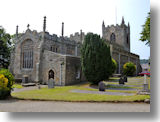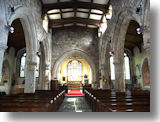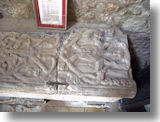Beaumaris - St Mary and St Nicholas
After Edward I defeated the native Welsh rulers in 1295 he began building a castle in this corner of Wales, and also issued a royal charter setting up a town mainly populated and run by English and Norman burgesses. Sometime after 1315 the townspeople petitioned the bishop of Bangor to consecrate a chapel in the town as a chapel of ease for the Llandegfan parish, saving them the trouble of having to travel to the main church in that village to worship. It was replaced by the current church in 1330.
The church is dedicated to saints Mary and Nicholas. The later, as well as being a model for Santa Claus, was the patron saint of many occupations, including sailors. It is perhaps because Beaumaris was an important port at the time that he was chosen for this church.
The bulk of what we see today is the original early 14th century church. The nave, two aisles on either side and the tower were all built at that time. A chancel was added around 1500, and new windows were added through the 16th century. A porch on the south side and a vestry next to the chancel were added in the 19th century. Also at that time the upper part of the tower was remodelled, with a set of bells and a clock added.
As is common with well-appointed churches such as this, the walls are lined with monuments to notable people of the town. Several of these, including some fine statues, commemorate various members of the Bulkeley family of Baron Hill, major landowners of the area. Another is dedicated to David Hughes, the man who founded the grammar school in the town in 1603 (now Ysgol David Hughes in Menai Bridge). The renowned botanist and naturalist Hugh Davies, who published Welsh Botanology in 1813, is eulogized on another memorial erected by his niece. A brass plaque listing those who had contributed money to the poor of the town includes the name "Tabora the Black", who gave a comparatively small annual sum of six shillings. It is thought that she was an African servant of the Bulkeley family.
The most notable monument is a late medieval alabaster tomb in the north aisle, with two figures lying on top. Tombs of this type of stone are uncommon in north Wales, but there is another one at St. Gredifael's, Penmynydd. The Beaumaris tomb has no inscriptions saying who the figures are, but it bears the arms of the Bulkeley family. It is thought to be either William Bulkeley and his wife Elen Gruffydd, or perhaps their son Rowland and his wife Alice Beconsall. Given the style of clothing of the figures, which seem to fit the mid to late 15th century, it is most likely the elder William, who died in either 1486 or 1490, rather than Rowland, who lived until 1537. William was the first of the Bulkeley family to come to Anglesey from Cheshire around 1444. He became a prominent landowner around Beaumaris and deputy constable of the Castle.
Another well-known and interesting tomb stands in the south porch. This plain stone coffin surmounted by a slab with a medieval carving of a woman is said to be the sarcophagus of Princess Joan, daughter of King John of England and wife of Llywelyn ap Iowerth (Llywelyn the Great). She died in 1237, aged around 45 years, at their palace at Abergwyngregyn. She is said to have loved the view across the Menai Strait to Anglesey, and when she died her heartbroken husband buried her near the opposite shore at Llanfaes, where he then founded a monastery.
There are competing and contradictory accounts of how the tomb came to the church after the dissolution of the monasteries. One says that Thomas Bulkeley took the effigy-carved slab from the monastery. to the church in 1538, another says that the slab was found face down in a ditch in the early 19th century. The coffin was discovered separately, being used as a horse watering trough, and was moved to a mausoleum on the Bulkeley's Baron Hill estate in 1808. It was moved to the church in the late 1920s.
Recently some doubt has been cast as to whether this is actually Joan's effigy. The style of the head dress, a wimple drawn up under the chin in a triangular shape, isn't known before the 1270s, and the style of the leafy decorations is characteristic of the late 13th century. The coronet worn by the figure indicates a royal person, and it may be that she is Eleanor de Monfort, wife of Llywelyn ap Gruffydd, who died in childbirth at Abergwyngregyn in 1282 and was also buried at Llanfaes.
Return to Churches and Chapels of Anglesey
Aerial image
View Churches and Chapels of Anglesey in a larger map
A new book by Warren Kovach, author of this web site






